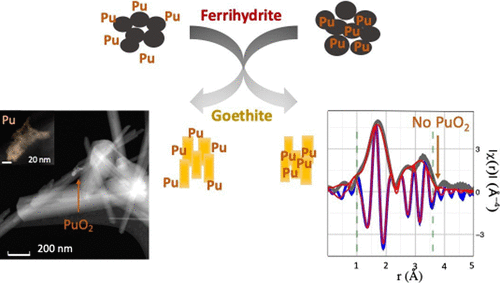当前位置:
X-MOL 学术
›
ACS Earth Space Chem.
›
论文详情
Our official English website, www.x-mol.net, welcomes your
feedback! (Note: you will need to create a separate account there.)
Transformation of Ferrihydrite to Goethite and the Fate of Plutonium
ACS Earth and Space Chemistry ( IF 2.9 ) Pub Date : 2020-10-27 , DOI: 10.1021/acsearthspacechem.0c00195 Enrica Balboni 1 , Kurt F. Smith 2 , Liane M. Moreau 2 , Tian T. Li 3 , Melody Maloubier 4 , Corwin H. Booth 2 , Annie B. Kersting 1 , Mavrik Zavarin 1
ACS Earth and Space Chemistry ( IF 2.9 ) Pub Date : 2020-10-27 , DOI: 10.1021/acsearthspacechem.0c00195 Enrica Balboni 1 , Kurt F. Smith 2 , Liane M. Moreau 2 , Tian T. Li 3 , Melody Maloubier 4 , Corwin H. Booth 2 , Annie B. Kersting 1 , Mavrik Zavarin 1
Affiliation

|
Understanding the interactions between plutonium and iron (oxy)hydroxide minerals is necessary to gain a predictive understanding of plutonium environmental mobility and to evaluate long-term performance of nuclear waste repositories. We investigated the fate of plutonium during the formation of ferrihydrite and its subsequent transformation into goethite. Ferrihydrite was synthesized with varying quantities of Pu(IV) following either a sorption or coprecipitation process; the ferrihydrite was then aged hydrothermally to yield goethite. The synthesized materials were characterized via extended X-ray absorption fine structure spectroscopy, transmission electron microscopy, and acid leaching to elucidate the nature of plutonium association with ferrihydrite and goethite. In samples prepared following the sorption method, plutonium was identified in two different forms: a PuO2 precipitate and a surface-sorbed plutonium complex. For the samples prepared via coprecipitation, no PuO2 formation occurs in the ferrihydrite precursor and in the goethite experiments where plutonium concentration is ≤1000 ppm (mg kg–1). In these coprecipitation products, plutonium is strongly bound to the minerals either via formation of an inner sphere complex, or via an incorporation process. In the coprecipitation experiments, PuO2 formation only occurs at the highest plutonium concentration (3000 ppm), suggesting that during ferrihydrite transformation into goethite, part of the plutonium can be remobilized to form PuO2 nanoparticles. Collectively, our results demonstrate that the nature of plutonium associated with the precursor ferrihydrite (adsorbed vs coprecipitated) will have a direct impact on the association of plutonium with its alteration product (goethite). Furthermore, the data illustrate that some properties of plutonium association with the precursor ferrihydrite are retained through the transformation into goethite. These findings show that plutonium strongly associates with iron (oxy)hydroxides formed through coprecipitation processes and in these materials, plutonium can be strongly retained by the iron minerals.
中文翻译:

水铁矿到针铁矿的转变和of的命运
了解p与氢氧化铁(氧)矿物质之间的相互作用对于获得对environmental环境迁移的预测性理解并评估核废料库的长期性能十分必要。我们研究了在水铁矿形成过程中and的命运以及其随后转变为针铁矿的过程。在吸附或共沉淀过程之后,合成了具有不同数量的Pu(IV)的三水铁矿。然后将水铁矿水热老化,生成针铁矿。合成的材料通过扩展的X射线吸收精细结构光谱,透射电子显微镜和酸浸进行表征,以阐明with与水铁矿和针铁矿缔合的性质。在按照吸附法制备的样品中,2沉淀物和表面吸附的complex络合物。对于通过共沉淀制备的样品,在水铁矿前体中和eth浓度≤1000ppm(mg kg – 1)的针铁矿实验中都不会形成PuO 2。在这些共沉淀产物中,p通过形成内球络合物或通过掺入过程与矿物质牢固结合。在共沉淀实验中,PuO 2的形成仅在最高concentration浓度(3000 ppm)时发生,这表明在水铁矿转化为针铁矿过程中,部分the可以被固定化以形成PuO 2。纳米粒子。总的来说,我们的结果表明,与前体水铁矿(吸附或共沉淀)缔合的the的性质将直接影响of与其改变产物(针铁矿)的缔合。此外,数据表明that与前体亚铁酸盐缔合的某些性质通过转变为针铁矿得以保留。这些发现表明,with与通过共沉淀过程形成的氢氧化铁(羟基)强烈缔合,在这些材料中,can可以被铁矿物质强烈保留。
更新日期:2020-11-19
中文翻译:

水铁矿到针铁矿的转变和of的命运
了解p与氢氧化铁(氧)矿物质之间的相互作用对于获得对environmental环境迁移的预测性理解并评估核废料库的长期性能十分必要。我们研究了在水铁矿形成过程中and的命运以及其随后转变为针铁矿的过程。在吸附或共沉淀过程之后,合成了具有不同数量的Pu(IV)的三水铁矿。然后将水铁矿水热老化,生成针铁矿。合成的材料通过扩展的X射线吸收精细结构光谱,透射电子显微镜和酸浸进行表征,以阐明with与水铁矿和针铁矿缔合的性质。在按照吸附法制备的样品中,2沉淀物和表面吸附的complex络合物。对于通过共沉淀制备的样品,在水铁矿前体中和eth浓度≤1000ppm(mg kg – 1)的针铁矿实验中都不会形成PuO 2。在这些共沉淀产物中,p通过形成内球络合物或通过掺入过程与矿物质牢固结合。在共沉淀实验中,PuO 2的形成仅在最高concentration浓度(3000 ppm)时发生,这表明在水铁矿转化为针铁矿过程中,部分the可以被固定化以形成PuO 2。纳米粒子。总的来说,我们的结果表明,与前体水铁矿(吸附或共沉淀)缔合的the的性质将直接影响of与其改变产物(针铁矿)的缔合。此外,数据表明that与前体亚铁酸盐缔合的某些性质通过转变为针铁矿得以保留。这些发现表明,with与通过共沉淀过程形成的氢氧化铁(羟基)强烈缔合,在这些材料中,can可以被铁矿物质强烈保留。











































 京公网安备 11010802027423号
京公网安备 11010802027423号